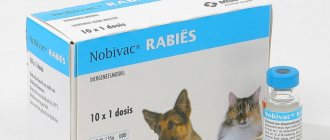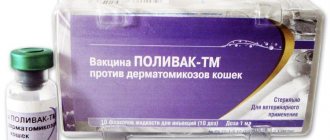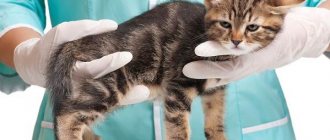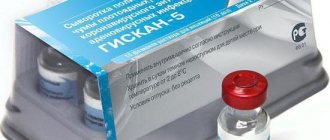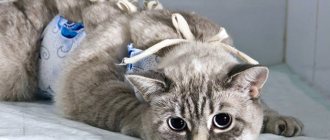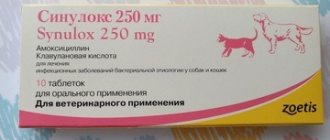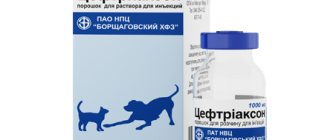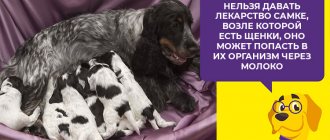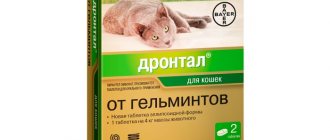General information about Polivak-TM
Polivak-TM is a vaccine used for the treatment and prevention of dermatomycosis (lichen). The manufacturer of the drug is (a division of the Russian scientific and production association "Narvak").
How the vaccine works
The purpose of the vaccine is to develop immunity against lichen in cats. The principle of “work” of Polivak-TM vaccinations is based on lightly infecting a cat with lichen so that the animal’s body learns to fight the disease. In the process of suppressing the introduced strains of the fungus, T-lymphocytes (protective cells that destroy pathogens) begin to be actively produced in the cat’s body. They remain in the blood for 10–12 months - if during this time the cat is “attacked” by fungal microorganisms, they will be immediately destroyed by lymphocytes. The formation of immunity capable of resisting lichen pathogens occurs 20 days after the first injection of Polivak-TM.
Composition of the drug
To prepare the vaccine, the manufacturer uses weakened strains of 8 species of fungi from the genus Trichophyton and Microsporum (they are causative agents of lichen in cats). One cubic centimeter of Polivak-TM contains at least 20 million lichen pathogens. All strains are interactive, that is, they are neutralized during the vaccine production process. This means that the injection cannot cause the clinical development of the disease in a cat (fungi from the drug are needed only to strengthen the immune system).
Release form
Polivak-TM is a clear or beige solution. During storage, a small amount of sediment may form in the form of flakes (when shaken, it quickly dissolves, but after 10–15 minutes it falls out again). The vaccine is produced in glass vials of 1 or 2 ml. The drug is sold in 1 bottle or in plastic boxes of 10 pieces.
Polivak-TM solution can be transparent or beige; slight precipitation in the form of white flakes is allowed
Attention: there are three types of Polivak-TM vaccine - with a suitable dosage for cats, dogs and horses. They can be distinguished by the color of the label on the package. The drug for cats is purple, for dogs - blue, for horses - brown.
On the right is the old packaging of Polivak-TM, which the manufacturer produced a couple of years ago; now the vaccine is packaged in plastic boxes, as in the photo on the left
Reviews
We live in our own house with a plot where the cat roams freely. They didn’t immediately notice that he had become infected with lichen; they only noticed when strange bald patches appeared on his paws, near his ears. At the veterinary hospital, the disease was confirmed - ringworm, the affected areas were highlighted with green light. An 8-year-old cat was vaccinated with the Polivac vaccine, a reliable and inexpensive drug, but the animal’s condition worsened, he was almost bald, and we were advised to euthanize him. It’s good that we took all measures to avoid getting infected ourselves.
Valentina S. Nakhabino
After an unpleasant incident with a dog, when weeping, bad-smelling sores appeared on the dog’s skin, I began to take vaccinations seriously. True, the infection with lichen was not confirmed, treatment was done with skin ointments, but once a year I take the dog to the veterinarian and give preventive injections with the Polivac TM vaccine. The drug is inexpensive, high-quality, and produces lasting immunity against fungal infection.
Irina
I don’t understand those who are careless about the health of their pets. Is it really difficult to get vaccinated against rabies and ringworm once a year? The Polivak TM vaccine costs mere pennies, is harmless to dogs and cats, and has virtually no side effects. Having given it to my dog, I am calm about the health of my loved ones, because infection from lichen is so dangerous.
Alexandra Ivanovna, Moscow
The body of any animal, including dogs, is susceptible to a huge variety of various diseases. As numerous studies by veterinarians show, every dog has a tendency to certain diseases. Such weak points of an animal are formed depending on such factors as: dog breed, age, heredity, feeding and maintenance habits, etc. However, there are a number of diseases from which no animal is immune. All kinds of skin diseases belong precisely to the category of such “universal” diseases.
Indications for use in cats
Dermatomycosis is a common skin and hair disease among cats. People usually call it lichen. Preventive vaccination is recommended by veterinarians due to the high risk of infection. Not only cats who walk outside and come into contact with sick animals can get lichen. Pets who never go outside can also suffer. In this case, infection occurs from care items (which were previously used to treat a sick animal), through a person (for example, the infection can be “brought” with you on street clothes and shoes).
Many types of lichen are contagious for both cats and humans
Annual vaccination with Polivak-TM reduces the likelihood of a cat becoming infected with lichen by several times. What is important is that the drug can be used not only for prevention, but also for the treatment of skin diseases. Adding Polivak-TM to symptomatic remedies allows you to eliminate the fungus 5–6 times faster compared to a course without the use of this remedy.
Fungal diseases of cats and dogs
Among the variety of infectious fungal diseases (there are 30 species), the most dangerous for the health and life of domestic animals is ringworm, which weakens the immune system and is easily transmitted from a sick animal to humans.
There are two types of this disease.
- Trichophytosis is characterized by damage to the skin and is a common disease in cats. It is accompanied by the presence of many small, contoured, hairless spots that stand out sharply on the skin and quickly spread throughout the body.
- In dogs with this disease, severe hair loss occurs, damaged areas of the skin become crusty, ulcers form, severe itching occurs, and claws become deformed.
- Microscopy affects the hair, cats experience broken hair loss, bald areas of the skin become inflamed, peel, and become covered with scales.
There are few initial signs of the disease; the latent period can last several days or months. Most often the area of the head, back, ears, and femoral paws is affected.
Dosage calculation and vaccination schedule
The drug Polivak-TM is administered intramuscularly. It is better to give the injection into the cat's back paw. The product can be administered to kittens older than 4 weeks.
Syringes are not included with the Polivak-TM vaccine; they will need to be purchased separately
For prevention
To develop immunity against dermatomycosis, 1 ml of the drug is administered to cats aged 1–5 months. For an animal older than six months, the dosage increases to 1.5 ml. When prophylactically, an animal that has never been vaccinated against lichen before requires a two-time administration with an interval of 21–28 days. If the animal has already been vaccinated, then one injection is enough. The next preventive course with Polivak-TM can be carried out after 12 months.
For treatment
If Polivak-TM is given to a cat diagnosed with dermatomycosis, then the dosage is 1.5 ml for kittens less than six months old and 2 ml for cats older than 6 months. Therapy requires three injections - they are given with a break of 10-14 days.
You should avoid violating the vaccination schedule and give a dose less than that specified in the instructions, as this reduces the effectiveness of the prevention and treatment provided.
Special instructions and precautions
When vaccinating, it is important to take measures to prevent infection from entering the injection wound. To do this, you need to disinfect the skin at the injection site (both before and after the injection). To do this, just wipe the desired area of the cat's paw with 70% ethyl alcohol or 0.5% carbolic acid solution. Syringes and needles must be disposable and must be disposed of after use.
Polivak-TM for cats is available in packaging with a purple label; preparations with stickers of other colors are not suitable for vaccinating cats
How to use?
The drug should be administered intramuscularly. Injections can be given in the following places:
- hind leg thigh;
- spatula;
- neck.
When carrying out vaccination, the following sequence of actions should be followed:
- Shake the bottle lightly to distribute the sediment evenly.
- For injection, use a disposable sterile syringe. Reusable needles should be boiled well before use.
- Puncture the rubber stopper and draw the liquid into the syringe.
- Be sure to wipe the injection site with alcohol or carbolic acid solution.
- Gently inject the drug into the muscle tissue.
A veterinarian's examination is required before injection.
If an animal suffers from ringworm, emollients should be used to speed up the exfoliation of damaged areas and tissue regeneration. Fish oil, lanolin, petroleum jelly or other oils used in veterinary medicine are perfect for these purposes. Oils should be applied to damaged areas several times a day.
It is necessary to take into account that when infected with ectoparasites or worms, as well as metabolic disorders, the effectiveness of the product is significantly reduced.
Polivak-TM for dogs cannot be used in the following cases:
- if the animal is weakened;
- when infected with infectious diseases;
- at elevated temperatures.
If the drug is used during the incubation period, the symptoms of the disease may become more pronounced. To avoid complications and unwanted reactions, the animal should be shown to a doctor.
Polivac usually does not cause side effects and is well tolerated by pets. In rare cases, the following may appear at the injection site:
- swelling;
- edema;
- redness.
When touched, the dog may experience pain, but such side effects do not require treatment. They pass without a trace in just 3-4 days.
Contraindications and side effects
The use of the Polivak-TM vaccine dosage recommended in the instructions is well tolerated by cats and does not lead to worsening of the condition. Not a single case of post-vaccination complications has been recorded, which confirms the safety of the drug. Slight swelling and inflammation at the site of vaccine administration are possible only due to incorrect placement of the injection, but not due to a side effect of the drug.
Important: if Polivak-TM is used in the treatment of existing dermatomycosis, then after the first two injections there may be a slight increase in the symptoms of the disease. You should not be afraid of this and stop the course. After the third injection of Polivak-TM, improvement occurs.
It makes no sense to give Polivak-TM to exhausted animals or cats with metabolic disorders and infected with ectoparasites, since the effectiveness of the vaccine is reduced by 2-3 times. It is imperative to improve the animal’s condition and only then vaccinate.
Cats in the last month of pregnancy, lactating animals and kittens under 1 month are not subject to vaccination.
Purpose
The Polivac TM vaccine is prescribed for the treatment of dermatomycosis caused by fungi of the genera Trichophyton and Microsporum. When infected with pathogenic fungi, a pet exhibits the following symptoms:
- baldness of certain areas of the body;
- redness of bald areas;
- itching and peeling of the skin.
With lichen, lesions appear primarily on the dog's face, stomach and paws. It is worth contacting a veterinarian if your pet has broken hairs or bald areas on its body. The dog may scratch the skin in the affected areas, the skin will peel off, and the body temperature may increase. Changes in behavior are observed: apathy, decreased appetite or impaired eating habits.
Polivak TM and local antifungal medications should not be taken without a veterinarian's prescription. During the examination, the doctor takes a scraping from the skin to determine the type of pathogen, and only then draws up a treatment regimen.
Table: comparison with other shingles vaccines
| Name | Compound | Indication | Contraindication | approximate price |
| Vakderm-F | 1 ml of the drug contains 50–80 million fungi Microsporum gypseum and Trichophyton mentagropytes. | Liquid vaccine for the prevention and treatment of feline ringworm | It should not be given to kittens under 1 month of age, in the second half of pregnancy, or to patients with infectious and inflammatory diseases in the acute stage. |
|
| Polyderm | 1 ml of the drug contains 10 million inactivated strains of fungi of the genus Trixophyton and Microsporum | Dry vaccine for the prevention and treatment of feline dermatomycosis | It is prohibited to vaccinate cats under 1 month of age, in the last weeks of pregnancy, or at elevated temperatures. | from 280 rub. per box of 4 ampoules of 1 ml. |
General description and composition
Among the huge number of drugs used in modern veterinary medicine to combat various types of fungal infections, the Polivak-TM vaccine for dogs is very popular. In comparison with expensive imported vaccines, the veterinary drug “Polivak-TM” is manufactured in Russia and, accordingly, is affordable for every dog breeder. The average cost of one vaccine ampoule can range from 45 to 70 rubles.
Despite its low cost, this drug is the most effective and safe means used for the treatment of dermatomycosis in animals. The active substance is inactivated strains (eight species) of fungi of the genus Microsporum and Trichophyton.
Externally, the vaccine is a homogeneous mass of a light brown solution. A slight sediment may form at the bottom of the glass ampoule, which will immediately dissolve by gently shaking the bottle.
Sterile containers are tightly sealed with rubber stoppers and covered with extra-thick foil. The vaccine is supplied in cardboard packages, each of which contains 10 ampoules of solution. In this case, one ampoule is one dose of the vaccine.
This drug should be stored, according to the manufacturer’s recommendations, in a place securely protected from children and animals. The shelf life is 18 months (from the date of manufacture indicated on the package).
>Video “Rules for dog vaccination”
In this video, an expert will tell you how to properly vaccinate dogs.
Characteristics of the veterinary product
The domestically produced vaccine is made from inactivated strains of the fungi trichophyton and microsporum. It is a homogeneous brownish liquid. It is allowed to have sediment at the bottom, which disappears when shaking. Polivak TM is produced in bottles or ampoules of one or two doses (0.6 and 1.2 milliliters, respectively) with markings, that is, indicating the date of manufacture and expiration date. The vaccine can be stored for 18 months from the date of manufacture at temperatures up to 10°C out of the reach of children. The instructions prohibit the use of the vaccine after the expiration date, in the absence of labeling, change in color, appearance of flakes and impurities, or damage to the integrity of the bottles.
The vaccine is intended for the prevention and treatment of dermatomycosis, the causative agents of which are the fungi trichophyton and microsporum. That is, vaccination with this drug protects dogs from lichen.
The instructions inform animal owners that immunity in pets after vaccination is formed 20-30 days after revaccination. It persists for one year after the administration of Polivak TM, a therapeutic and prophylactic drug. It is worth noting that this drug is harmless for representatives of all dog breeds and ages. It is advisable to vaccinate puppies with this veterinary remedy from the age of two months.
